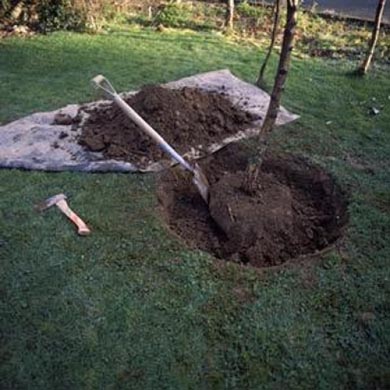How To Plant A Containerised Tree
 When digging the hole into which the plant will be placed, always ensure that the diameter or width is greater than the root spread of each plant. Carefully lay aside the excavated soil beside the hole. The quality of the soil has to be ascertained at this stage and any additions to the soil, whether they be planting compost, organic material, rough sand, or fertiliser should be thoroughly mixed through the excavated soil on the surface before it is returned as backfill around the roots of the plant.
When digging the hole into which the plant will be placed, always ensure that the diameter or width is greater than the root spread of each plant. Carefully lay aside the excavated soil beside the hole. The quality of the soil has to be ascertained at this stage and any additions to the soil, whether they be planting compost, organic material, rough sand, or fertiliser should be thoroughly mixed through the excavated soil on the surface before it is returned as backfill around the roots of the plant.
- Prior to planting containerised plant material care must be taken to ensure that the roots and soil in the container are moist. The container should be watered well in advance of planting to ensure that the whole of the root structure is thoroughly wet.
- Before planting, the pot or plastic container should be removed and set aside. Quite often the root system in a container is very condensed and where this is the case the bottom of the root system and the roots around the edge of the container should be teased out gently taking care to avoid breaking down the shape of the root structure and damaging the roots
- The best method of staking trees which have been produced in containers or pots is the double staking method. This method prevents damage to the root system of the tree. The stakes should be driven into the ground at the base of the excavated it before the tree is placed
- The plant should be placed in the hole, and the backfill material returned and firmed around the root system. Gentle but firm pressure can be applied to the backfill material around the plant by boot heels or by treading, but the soil should not be compacted
- Make sure the planting area is free of weeds for at least two years and water is important for new plants. Watering should be regular for the first year of the new plant life. Test for sufficient moisture by using your finger. Dig down about 2-4 inches just outside the root mass of the plant and water if the soil feels dry.
- Newly planted shrubs, trees, etc should be checked and watered every other day for the first two weeks at least. After the first two weeks limit watering to once a week if less than 1 inch of rain falls during the week. Thorough soakings that moisten the soil to the entire depth of the root mass are better than frequent light watering.

